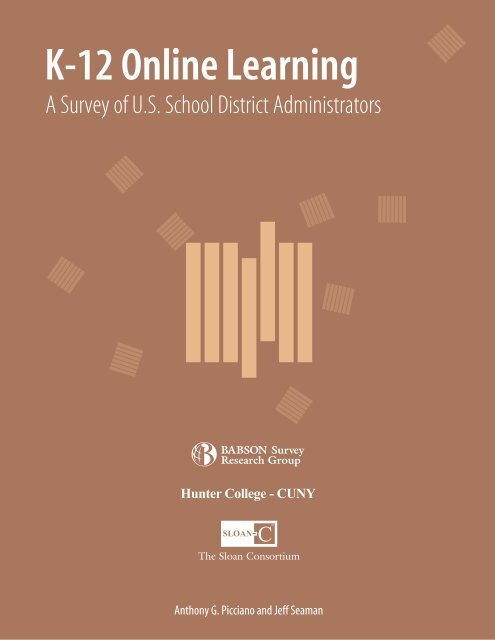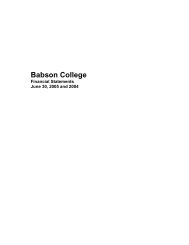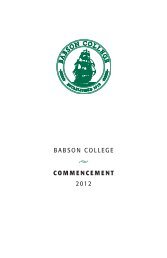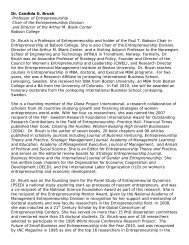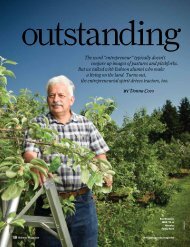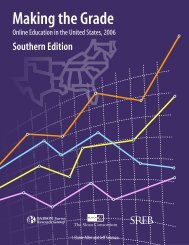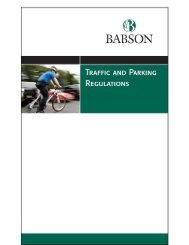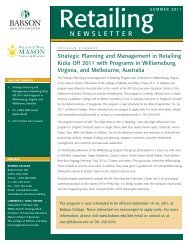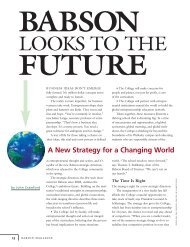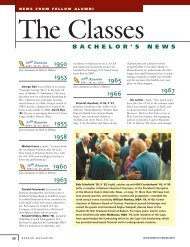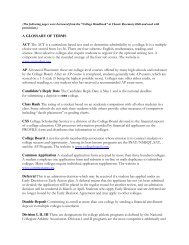K-12 Online Learning - The Sloan Consortium
K-12 Online Learning - The Sloan Consortium
K-12 Online Learning - The Sloan Consortium
Create successful ePaper yourself
Turn your PDF publications into a flip-book with our unique Google optimized e-Paper software.
K-<strong>12</strong> <strong>Online</strong> <strong>Learning</strong><br />
A Survey of U.S. School District Administrators<br />
Hunter College - CUNY<br />
Anthony G. Picciano and Jeff Seaman
K–<strong>12</strong> ONLINE LEARNING: A SURVEY OF U.S.<br />
SCHOOL DISTRICT ADMINISTRATORS<br />
Anthony G. Picciano<br />
Professor, School of Education,<br />
Hunter College and Graduate Center of the<br />
City University of New York<br />
e-mail – anthony.picciano@hunter.cuny.edu<br />
Jeff Seaman, Ph.D.<br />
Chief Information Officer, Survey Director<br />
<strong>The</strong> <strong>Sloan</strong> <strong>Consortium</strong><br />
Olin and Babson Colleges<br />
Co-Director, Babson Survey Research Group<br />
Babson College<br />
Neither this report nor any part maybe reproduced or transmitted in any form or by any means, electronic<br />
or mechanical, including photocopying, microfilming, and recording, or by any information storage or<br />
retrieval system, without prior permission in writing from the publisher.<br />
<strong>The</strong> consent of the <strong>Sloan</strong> <strong>Consortium</strong> (<strong>Sloan</strong>-C) does not extend to copying for general distribution, for<br />
promotion, for creating new works, or for resale. Specific permission must be obtained in writing from<br />
<strong>Sloan</strong>-C for such copying. Direct all inquiries to <strong>Sloan</strong>-C, at Olin Way, Needham, MA 02492-<strong>12</strong>00, or to<br />
publisher@sloan-c.org.<br />
Copyright ©2007 by <strong>Sloan</strong>-C<br />
All rights reserved. Published 2007<br />
Printed in the United States of America<br />
9 8 7 6 5 4 3 2 1
ABSTRACT<br />
<strong>The</strong> research literature on online learning has grown significantly in the past decade. Many studies have<br />
been published that examine the extent, nature, policies, learning outcomes, and other issues associated<br />
with online instruction. While much of this literature focuses specifically on postsecondary education<br />
with approximately three million students presently enrolled in fully online courses [1], not as much has<br />
been published about students enrolled in fully online and blended courses in primary and secondary<br />
schools. This is one of the first studies to collect data on and to compare fully online and blended<br />
learning in K-<strong>12</strong> schools. <strong>The</strong> purpose of this study was to explore the nature of online learning in K–<strong>12</strong><br />
schools and to establish base data for more extensive future studies. Issues related to planning,<br />
operational difficulties, and online learning providers were also examined. This study does not<br />
necessarily answer all of the issues raised but hopefully will promote further discussion and study of<br />
them.<br />
KEYWORDS<br />
<strong>Online</strong> <strong>Learning</strong>, Distance <strong>Learning</strong>, Blended <strong>Learning</strong>, Distance Education, Asynchronous <strong>Learning</strong>,<br />
Primary Education, Secondary Education, K–<strong>12</strong><br />
I. INTRODUCTION<br />
On November 9, 2006, the <strong>Sloan</strong> <strong>Consortium</strong> issued its fourth annual report on the extent of online learning<br />
in American colleges and universities [1]. Based on a national survey, this report provided information on<br />
student enrollments, operational concerns, and planning issues as seen through the eyes of chief academic<br />
officers. <strong>The</strong> report confidently estimates that 3 million students are registered for fully online courses in<br />
colleges and universities. An online course was defined “as 80 percent of the course is delivered online.”<br />
<strong>The</strong> chief academic officers to whom the survey was sent also reported that online learning was becoming a<br />
“critical” part of their long-term planning strategies. This was true especially for those in public colleges<br />
and universities where student access to an education is a critical part of their mission.<br />
Earlier in 2006, on March 17th, Penn State University hosted the <strong>Sloan</strong> K–<strong>12</strong> Higher Education<br />
Collaboration in <strong>Online</strong> <strong>Learning</strong>, a meeting that was held at the Corporation for Public Broadcasting in<br />
Washington, DC. Thirty-five individuals were invited to discuss issues related to collaboration in online<br />
learning between K–<strong>12</strong> schools and colleges and universities. All of the individuals invited had experience<br />
or expertise in online learning and represented a wide spectrum of K–<strong>12</strong> schools, colleges and online<br />
learning providers. While the discussions during this meeting were rich in possibilities for collaboration, the<br />
need for more data on online learning in K–<strong>12</strong> schools became increasingly apparent. While estimates were<br />
discussed, concerns were expressed that hard data were not readily available and that the last major national<br />
study done by the U.S. Department of Education that focused on generic distance education, was based on<br />
data that were four years old.<br />
<strong>The</strong>re are a number of underlying reasons why these data are not available. First, there are minimal if any<br />
requirements in many states to collect data on their online students. A number of states have not established<br />
any specific guidelines or data collection processes for online students, and those policies that do exist, are<br />
inconsistent. Watson, in a study of state policies on online learning in 2005, observed that many “state<br />
policymakers have moved … slowly” [2, p. 10].<br />
Second, there is some confusion related to definitions of online learning and distance education. Distance<br />
education is not equivalent to online learning. Other instructional modalities not directly related to the<br />
Internet, such as videoconferencing and televised courses, are still quite popular in many areas of the<br />
country. Furthermore, within the online environment, definitions and terms such as “fully online”, “blended<br />
Page 1
courses”, “virtual courses”, “e-learning”, “hybrid courses”, “mixed-mode”, “asynchronous learning”,<br />
“distributed learning”, “Web-facilitated”, and “Web-enhanced learning” abound; contributing to confusion<br />
among many educators. Problems of definition are not new especially when dealing with rapidly evolving<br />
instructional technologies.<br />
<strong>The</strong> <strong>Sloan</strong>-C study conducted by Allen & Seaman [1] distinguished and defined three types of online<br />
courses:<br />
<strong>Online</strong> — Course where most or all of the content is delivered online. Defined as at least 80% of<br />
seat time being replaced by online activity.<br />
Blended/Hybrid — Course that blends online and face-to-face delivery. Substantial proportion (30<br />
to 79%) of the content is delivered online.<br />
Web-Facilitated — Course that uses web-based technology (1 to 29% of the content is delivered<br />
online) to facilitate what is essentially a face-to-face course [1].<br />
<strong>The</strong>se definitions meet the needs of the <strong>Sloan</strong> <strong>Consortium</strong> study well, where consistency of terminology<br />
is absolutely essential to ensure the data collected reflect the same activities from year to year.<br />
For research and data collection in K–<strong>12</strong> schools, similar definitions need to be discussed and established.<br />
Without clearly defined terms, activities that can be considered online learning can significantly overlap<br />
and might confuse serious study, rather than add to our knowledge. For example, a high school student<br />
enrolled in a fully online Advanced Placement English course at a nearby college and another student<br />
who does a Webquest as a research assignment in a history course that meets face-to-face might both be<br />
engaged in online learning, yet their learning activities are significantly different. Using the definitions<br />
established by Allen & Seaman, the former scenario qualifies as a fully online course with student and<br />
teacher physically separated and minimally, if ever, meeting face-to-face; the latter would be considered a<br />
Web-enhanced course with student and teacher meeting in a regular classroom, as would any other faceto-face<br />
course. Unfortunately, generally accepted definitions have not been established.<br />
Third, some of the difficulty in data collection can also be attributed to the significant growth in the<br />
number of public, private and for-profit providers of online services, many of which operate outside of the<br />
traditional school district structure. <strong>The</strong>se include:<br />
• Other school districts that provide online learning courses<br />
• Charter schools within a district<br />
• Charter schools outside of a district<br />
• State supported virtual schools within a state<br />
• State supported virtual schools outside of a state<br />
• State technology service agencies<br />
• Colleges and universities<br />
• Consortial agencies<br />
• Private, for-profit entities that offer selected courses<br />
• Private, for-profit virtual schools<br />
While the growth in online learning providers is indicative of the popularity of online learning, it<br />
complicates the collection of accurate data by moving students partially or fully outside the school district<br />
for educational services. It also allows online learning providers to operate across state lines. In some<br />
cases, where the school district pays for the services, it is acutely aware of which students are enrolled. In<br />
other cases, school districts have little if any knowledge of the number of students taking advantage of<br />
online learning from an outside provider. During a follow-up telephone discussion to the present study with<br />
one high school principal, he indicated that his school district administration has no mechanism in place for<br />
collecting data on online students.<br />
Page 2
Fourth, the home schooling movement is alive, well and growing and operates almost as a “subculture” with<br />
minimum oversight other than meeting compulsory attendance regulations. [4] Many home schoolers use<br />
online service providers for a portion of their course work without any need to report same to any<br />
educational agency or authority. <strong>The</strong> data on this population of online students is perhaps the least known<br />
of any K–<strong>12</strong> population.<br />
<strong>The</strong> purpose of this study was to explore the nature of online learning in K–<strong>12</strong> schools and to establish base<br />
data for more extensive future studies. Issues related to planning, operational difficulties, and online<br />
learning providers were examined. This study will not necessarily resolve all of the issues raised but will<br />
hopefully promote further discussion of them.<br />
II. REVIEW OF THE LITERATURE<br />
Berge and Clark provide an appropriate starting point for examining issues related to online learning in K–<br />
<strong>12</strong> schools [5]. <strong>The</strong>ir book, Virtual Schools: Planning for Success, contains a number of important chapters<br />
identifying case studies, best practices, and important planning issues related to K–<strong>12</strong> online learning.<br />
However, on page one, the authors referred to a study done in 2001 by one of the authors [6] that estimated<br />
K–<strong>12</strong> online learning at 40,000 to 50,000 students. In all likelihood, by 2005 when the Berge and Clark<br />
book was published, this enrollment estimate was too low but exemplified the paucity of research and the<br />
need for more accurate and timely data. <strong>The</strong> authors recommended that a national survey be conducted of<br />
K–<strong>12</strong> schools. <strong>The</strong> authors also referred to a pending report by the U.S. Department of Education that might<br />
shed more light on K–<strong>12</strong> online learning.<br />
Watson, in a national study of state policies on K–<strong>12</strong> online learning conducted in 2005 reported that a<br />
number of states had not formally established policies on online learning. Furthermore, while there had<br />
been explosive growth in online learning, “relatively little was known about the [K–<strong>12</strong>] programs that<br />
conducted online learning.” [2, p. 10].<br />
In 2005, the U.S. Department of Education [7] issued the first comprehensive examination of distance<br />
education in the K–<strong>12</strong> schools, entitled Distance Education Courses for Public Elementary and Secondary<br />
School Students: 2002–03. This report, referred to by Berge and Clark above, was based on data collected<br />
during the 2002–2003 academic year and reported that one-third (36%) of public school districts and nine<br />
percent of public schools had students enrolled in distance education courses in 2002–03. In this study,<br />
distance education referred to courses taken for credit and offered to elementary and secondary school<br />
students where the teacher and student are in different locations. It included any technology or modality for<br />
delivering distance education to K–<strong>12</strong> schools and did not concentrate exclusively on online learning.<br />
Questionnaires for the survey on which the report was based were mailed to a representative sample of<br />
2,305 public school districts in the 50 states and the District of Columbia. <strong>The</strong> findings in the report were<br />
organized under: distance education for public school students; technologies used for delivering distance<br />
education courses; entities delivering distance education courses; reasons for having distance education<br />
courses; and future expansion of distance education courses. Key findings from the survey included:<br />
• A greater proportion of large districts than medium or small districts had students enrolled in<br />
distance education courses (50% vs. 32% and 37%, respectively). In addition, a greater<br />
proportion of districts located in rural areas than in suburban or urban areas indicated that<br />
they had students enrolled in distance education courses (46% compared with 28% and 23%,<br />
respectively).<br />
• <strong>The</strong> percentage of schools with students enrolled in distance education courses varied<br />
substantially by the instructional level of the school. Overall, 38 percent of public high<br />
schools offered distance education courses, compared with 20 percent of combined or<br />
Page 3
ungraded schools, 4 percent of middle or junior high schools, and fewer than 1 percent of<br />
elementary schools.<br />
• In 2002–03, there were an estimated 328,000 enrollments in distance education courses<br />
among students regularly enrolled in public school districts. Students enrolled in multiple<br />
courses were counted for each course taken. Thus, enrollments may include duplicated<br />
counts of students.<br />
• Of the total enrollments in distance education courses, 68 percent were in high schools, 29<br />
percent were in combined or ungraded schools, 2 percent were in middle or junior high<br />
schools, and 1 percent were in elementary schools.<br />
• <strong>The</strong>re were an estimated 45,300 enrollments in Advanced Placement or college-level courses<br />
offered through distance education in 2002–03. This represents 14 percent of the total<br />
enrollments in distance education.<br />
• <strong>The</strong> proportion of all distance education enrollments that are in Advanced Placement or<br />
college-level distance education courses is greater in small districts compared to medium or<br />
large districts (24% vs. 10% and 7%, respectively).<br />
• When asked which technology was used to deliver the greatest number of distance education<br />
courses, 49 percent of districts reported two-way interactive video, more than any other<br />
technology.<br />
• Of those districts with students enrolled in distance education courses in 2002–03, about half<br />
(48%) had students enrolled in distance education courses delivered by a postsecondary<br />
institution. Thirty-four percent of districts had students enrolled in distance education<br />
courses delivered by another local school district, or schools in other districts, within their<br />
state.<br />
• Seventy-two percent of districts with students enrolled in distance education courses planned<br />
to expand their distance education courses in the future.<br />
• Thirty-six percent of districts that were planning to expand their distance education courses<br />
selected course development and/or purchasing costs as a major factor preventing their<br />
expansion [7].<br />
Approximately 50 percent of the total distance education course enrollments of 328,000 or 164,000 were<br />
Internet-based or online. However, because students might be taking courses in multiple or mixed<br />
modalities, the actual estimates cannot be considered exact. Also because the data collected were based on<br />
course enrollments and not on students enrolled, it is likely that the number of students enrolled in K–<strong>12</strong><br />
online courses was substantially lower. <strong>The</strong> rationale is that a student who takes a full academic program<br />
online might be enrolled in multiple and as many as six courses in a semester. While accurate as a course<br />
enrollment estimate, these data are not equivalent to the number of students enrolled in online learning.<br />
Based in part on the U.S. Department of Education data reported above as well as several other studies,<br />
Smith, Clark, and Blomeyer projected that K–<strong>12</strong> online enrollments would be as high as 600,000 students in<br />
2005 [8]. <strong>The</strong>y indicated that this number was an estimate based on other studies and not on primary data<br />
that they had collected. Compared to the 164,000 online course enrollments reported by the U.S.<br />
Department of Education for 2002–2003 [7], this estimate seems high but it is not necessarily inaccurate.<br />
Another report in Education Week in 2006 estimated the number of online enrollments at more than one<br />
million students based on reports from <strong>The</strong> Peak Group and WestEd [9]. This estimate also seems high as<br />
compared to the U.S. Department of Education data for 2002–2003. Smith, Clark, & Blomeyer aptly<br />
concluded that there were significant barriers to research on K–<strong>12</strong> online learning, the first of which was<br />
limited access to accurate and timely data [8].<br />
Page 4
While student outcomes are not the specific foci of this study, one major study by Cavanaugh, Gillan,<br />
Kromey, Hess, & Blomeyer [10] is worth mentioning. <strong>The</strong>y completed a meta-analysis of fourteen studies<br />
focusing specifically on student outcomes. <strong>The</strong>ir conclusion was:<br />
Students can experience similar levels of academic success while learning using<br />
telecommunications and learning in classroom settings. While distance learning as it<br />
is practiced in today’s virtual schools uses technology that is less than ten years old<br />
and advances rapidly, the literature has shown that a student’s education online can be<br />
as effective as it is in a classroom,…<br />
<strong>The</strong> result shows variation in the degree of success students have experienced, and a<br />
need for more information if firm conclusions are to be drawn. [10, p. 21–22].<br />
<strong>The</strong> findings in Cavanaugh et al. were similar to other studies conducted on online learning in both K–<strong>12</strong><br />
and higher education in which “no significant difference” was found in student learning in online courses<br />
versus face-to-face courses. It would appear that a body of research is developing on student performance<br />
in individual, case study online courses while research on broader issues of the nature of online learning<br />
in the larger K–<strong>12</strong> universe is less available.<br />
As a conclusion to this review of the literature, the present researchers believe that a study that looks at<br />
issues across a broad spectrum of K–<strong>12</strong> education will be useful in understanding how online learning is<br />
being deployed and more importantly perceived by chief school administrators as a viable option for<br />
delivering instruction.<br />
III. METHODOLOGY<br />
This study of K–<strong>12</strong> instruction used descriptive analysis relying extensively on a survey instrument (see<br />
Appendix A) designed specifically for the project. <strong>The</strong> instrument was patterned after a similar<br />
instrument used by <strong>The</strong> <strong>Sloan</strong> <strong>Consortium</strong> to conduct national surveys of chief academic officers in<br />
American colleges and universities. Follow up telephone discussions were also conducted with selected<br />
respondents in an attempt to verify and gain further insights into what was reported on the survey. This<br />
survey was conducted for the 2005–2006 academic year.<br />
<strong>The</strong> “universe of interest” for this study included all public school districts in the United States that<br />
operate schools (16,098). Information on these districts was taken from the Common Core of Data<br />
(CCD) from the U.S. Department of Education's National Center for Education Statistics<br />
(http://nces.ed.gov/ccd/ccddata.asp).<br />
<strong>The</strong> study used three outreach efforts:<br />
1. A postcard invitation to participate in the survey was sent to a random sample of<br />
7,700 school districts using the postal mailing addresses in the federal data. Each<br />
post card contained a brief description of the survey, a URL where they the survey<br />
could be completed and a unique Survey ID number for the respondent to use to<br />
activate their survey form.<br />
2. An email invitation was sent to randomly selected school districts using a<br />
commercial source for email addresses. <strong>The</strong> commercial source was able to provide<br />
email addresses for approximately one-half of all the school districts. A reminder<br />
email message was sent two weeks after the first message. Both the invitation and<br />
Page 5
the reminder message contained a unique URL that, when clicked, would open up the<br />
survey form in a web browser and pass the unique survey ID.<br />
3. Approximately 1,200 randomly-selected school districts were sent a paper copy of a<br />
letter of invitation along with a paper copy of the survey form and a business reply<br />
envelope. <strong>The</strong>se respondents were also presented with a web-based option to<br />
respond. Both the paper and web-based version of the survey contained a unique<br />
survey identification number.<br />
All potential respondents were informed of the funding source for the study (the Alfred P. <strong>Sloan</strong><br />
Foundation), who was conducting it (“researchers at Hunter and Babson Colleges”) and that “All<br />
responses will be held in strictest confidence and at no time will districts or respondents be identified by<br />
name.” <strong>The</strong> survey form was composed of two portions, one that applied to all respondents and a second<br />
section to be completed only by those districts with online or blended course offerings. <strong>The</strong> invitation<br />
letter and the survey form itself were carefully worded to encourage responses from all school district<br />
representatives, regardless of whether they were involved with online learning or not.<br />
All data collected were entered into an online database, either directly by the respondent or, in the case of<br />
paper-based responses, by the researchers. Each entry included the unique survey ID number that was<br />
used to link the response to the description data of that school district contained in the Education's<br />
National Center for Education Statistics Common Core of Data. <strong>The</strong> data linked from this source<br />
included location information (city, town, state, urban/rural), the grade range in the district, the number of<br />
students in the district, and the number of teachers in the district.<br />
All data were investigated for missing or out of range values. All missing data were coded as either<br />
structural missing (the question did not apply to the respondent) or as non-response missing (the question<br />
did apply, but the respondent did not provide any data). After the survey data were merged with the CCD<br />
data, cleaned, and all missing value codes added, they were input into the SPSS statistical package for<br />
analysis.<br />
<strong>The</strong> analysis data set contains 366 records (N=366), representing 2 percent of all school districts of<br />
interest. Responses were received from school districts in forty-four states.<br />
<strong>The</strong> major research questions that guided this study were:<br />
1. What is the nature and extent of online and blended learning in K–<strong>12</strong> schools in the<br />
United States<br />
2. What is the perceived importance of online and blended learning for K–<strong>12</strong> school<br />
programs<br />
3. What are the issues and barriers that impede the development of online and blended<br />
learning in K–<strong>12</strong> schools<br />
4. Who are the major providers of online and blended learning courses to K–<strong>12</strong><br />
schools<br />
In conducting this survey, it was determined that there needed to be a separation of online from blended<br />
learning courses. In the absence of any standard definitions for online and blended learning, the<br />
definitions used by Allen & Seaman for the <strong>Sloan</strong> <strong>Consortium</strong> studies of American higher education were<br />
adopted, namely:<br />
Page 6
<strong>Online</strong> — courses where most or all of the content is delivered online. Defined as at least<br />
80% of seat time being replaced by online activity.<br />
Blended/Hybrid — courses that blends online and face-to-face delivery where a<br />
substantial proportion (30 to 79%) of the content is delivered online.<br />
<strong>The</strong> separation of online and blended courses is important and distinguishes this study from the research<br />
previously cited that focused specifically on generic distance education or fully online learning.<br />
IV. FINDINGS<br />
A. Respondent Characteristics<br />
<strong>The</strong> population that participated in this survey represents a cross section of American K–<strong>12</strong> education.<br />
Three hundred and sixty-six (N=366) out of a total universe of 16,000 school districts in the United States<br />
responded to this survey. <strong>The</strong> school districts responding represent approximately 3,632 schools, 2 million<br />
students, and 67,000 FTE teachers from every region (New England, Middle Atlantic, Southeast, Midwest,<br />
North Central, Southwest, Mountain, and West Coast) of the country. <strong>The</strong> locale of these school districts is<br />
presented in Table 1. Definitions of these locales are based on the U.S. Department of Education National<br />
Center of Education Statistics (NCES) codes (see Appendix B for definitions).<br />
Frequency<br />
Percent<br />
Large City 5 1.4<br />
Mid-Size City 18 4.9<br />
Urban Fringe of a Large City 77 21.0<br />
Urban Fringe of a Mid-Size City 56 15.3<br />
Large Town 3 .8<br />
Small Town 42 11.5<br />
Rural, outside CBSA 104 28.4<br />
Rural, inside CBSA 61 16.7<br />
Total 366 100.0<br />
Table 1. Locales of Respondents (NCES code used for locale;<br />
CBSA = Core-Based Statistical Area)<br />
B. Nature and Extent of <strong>Online</strong> and Blended <strong>Learning</strong><br />
Table 2A shows that 57.9 percent of the school districts reporting had at least one student who had taken an<br />
online course in 2005–2006. It also shows that an additional 24.5 percent of those which did not have any<br />
students enrolled in an online class planned to have at least one student take an online course within the next<br />
three years. Table 2B indicates that 32.4 percent of the school districts reporting had at least one student<br />
take a blended course. It also indicates that an additional 27.1 percent of those which did not have any<br />
students enrolled in a blended course planned to have at least one student take a blended course within the<br />
next three years. Nearly two thirds of all districts (63.1%) currently have students taking either online or<br />
blended courses with another 20.7 percent planning to introduce them over the next three years. <strong>The</strong>se data<br />
clearly reflect that the majority of American school districts are providing some form of online learning for<br />
their students and many more plan to do so within the next three years.<br />
Page 7
Frequency<br />
Valid<br />
Percent<br />
No 64 17.6<br />
Plan 89 24.5<br />
Yes 210 57.9<br />
Total 363 100.0<br />
Missing 3<br />
Total 366<br />
Table 2A. Responses to: Are students at the [school district name] taking any fully online courses<br />
during the 2005–2006 (<strong>12</strong> month) school year<br />
Frequency<br />
Valid<br />
Percent<br />
No 145 40.5<br />
Plan 97 27.1<br />
Yes 116 32.4<br />
Total 358 100.0<br />
Missing 8<br />
Total 366<br />
Table 2B. Responses to: Are students at the [school district name] taking any blended/hybrid courses<br />
during the 2005–2006 (<strong>12</strong> month) school year<br />
As a follow-up question to the above, respondents in school districts already enrolling students in online or<br />
blended courses were asked if they anticipated growth in enrollments over the next two years. A majority of<br />
the respondents anticipated growth (60.1% of districts expect growth in their fully online course enrollments<br />
and 66.0% expect growth in their blended enrollments). Districts predict that the number of students taking<br />
online courses will grow by 18.6 percent and those taking blended courses will grow by 22.9 percent over<br />
the next two years.<br />
Table 3 shows the grade levels of the students taking online courses as categorized by fully online and<br />
blended/hybrid courses. Not surprisingly, the data show that much higher percentages of students are<br />
enrolled in online courses in the upper levels with the majority at the high school level.<br />
Fully <strong>Online</strong> Blended/Hybrid Total<br />
N % N % N %<br />
Grades K–5 2733 16% 538 5% 3271 <strong>12</strong>%<br />
Grades 6–8 1793 10% 3980 36% 5773 20%<br />
Grades 9–<strong>12</strong> <strong>12</strong>625 73% 6519 59% 19144 67%<br />
Other 198 1% 56 1% 254 1%<br />
Total 17349 100% 11093 100% 28442 100%<br />
Table 3. <strong>Online</strong> Enrollment by Grade Level<br />
An important goal of this study was to estimate the number of K–<strong>12</strong> students enrolled in online learning and<br />
Page 8
to help establish baseline data through comparisons with other research. <strong>The</strong> respondents in this study<br />
reported that the total number of students enrolled in fully online courses was 17,349 and the total number<br />
of students enrolled in blended courses was 11,093 for a grand total of 28,442 students. An extrapolation of<br />
these figures estimates that approximately 700,000 students for the entire population of 48,000,000 public<br />
school students were enrolled in online and blended learning courses. This figure is close to the projected<br />
600,000 students enrolled in online courses for 2005 made by Smith, Clark, and Blomeyer [8]. Based on the<br />
data collected in this study for 2005–2006 and the Smith, Clark, and Blomeyer study for 2005, an estimated<br />
600,000 to 700,000 K–<strong>12</strong> public school students were enrolled in online learning for 2005–2006. It is likely<br />
that the higher figure is more accurate given that the data in this study is more current and extends into<br />
2006, a year longer than Smith, Clark, and Blomeyer. A caution needs to be mentioned regarding this<br />
estimate. This estimate is based on data collected from public schools only. Approximately six million<br />
private school students and one million home-schooled students were not included in the sample. This<br />
would indicate that the number may be higher but determining to what extant is beyond the scope of this<br />
study.<br />
C. Perceived Importance of <strong>Online</strong> and Blended <strong>Learning</strong><br />
<strong>The</strong> answers to question number 3 provide insight into the main reasons why online and blended courses are<br />
perceived as important by the respondents. For purposes of presentation, the seven-point Likert scale used<br />
to provide options in the survey was recoded into a three point scale with 1 = Not Important, 2 = Neutral,<br />
and 3 = Important. <strong>The</strong> mean responses are provided in Table 4. <strong>The</strong>se results indicate that the perceived<br />
importance of online learning related mostly to the following:<br />
1. Offering courses not otherwise available at the school<br />
2. Meeting the needs of specific groups of students<br />
3. Offering Advanced Placement or college-level courses<br />
4. Reducing scheduling conflicts for students<br />
5. Permitting students who failed a course to take it again<br />
Not Important Neutral Important<br />
Offering courses not otherwise available at the school<br />
Meeting the needs of specific groups of students<br />
Offering Advanced Placement or college-level courses<br />
Reducing scheduling conflicts for students<br />
Permitting students who failed a course to take it again.<br />
Certified teachers are not available for traditional face-to-face instruction<br />
Addressing growing populations and limited space<br />
<strong>Online</strong> and blended offerings are financially beneficial<br />
<strong>Online</strong> and blended offerings are pedagogically more beneficial<br />
Students prefer online course activities<br />
0 10 20 30 40 50 60 70 80 90 100<br />
Table 4. Percentage Summary of Responses to: How important do you believe the following reasons are for a school<br />
district to offer fully online or blended learning courses<br />
Page 9
<strong>The</strong> respondents were predominantly neutral with regard to the other reasons provided in the survey. In<br />
terms of the second reason “Meeting the needs of specific groups of students” a sample of descriptions of<br />
these “specific groups” provided by the respondents follows:<br />
“Students reasons for taking an online class vary widely. Some were making up lost credits,<br />
some were taking AP classes not offered at their own school, and others were trying to get extra<br />
credits to graduate early. Still others would take a reduced schedule at their home school and<br />
leave early enough in the day to go to a job while making up the online time at their<br />
convenience.”<br />
“We only use online courses to enable students to gain credits who otherwise would be unable to<br />
graduate with their classmates due to schedule constraints. “<br />
“We offer online courses for remedial purposes and the occasional homebound student. “<br />
“Our blended online program is increasing most significantly with our ELL population and our<br />
contract alternative schools.”<br />
“<strong>The</strong> students … take summer courses, mainly in mathematics, from universities such as Stanford<br />
to allow them to fulfill a required course… It allows them to take more advanced courses during<br />
their 4 years of high school.”<br />
“We’re looking into serving kids who have (a) failed a requirement, rather than re-enrolling them<br />
in an on-campus course, (b) selected electives, and (c) Advanced Placement offerings where the<br />
local enrollment is too low to warrant an on-campus teacher.”<br />
“We have been using online courses for the past few years… to meet the needs of foreign<br />
language courses. “<br />
“We use online course work for students who miss school to the point of no longer being able to<br />
pass the regular class.”<br />
“Many students are enrolled in dual credit college credits through high school regional<br />
academies; this is the fastest growing area of course offerings for our students.”<br />
“Blended courses give [us] the opportunity to offer advanced and remedial classes we cannot<br />
provide.”<br />
“It meets the needs of a few students that have mastered our 8th grade curricula and are taking<br />
advanced high school courses, especially in mathematics and world languages.”<br />
“<strong>Online</strong> courses have helped especially with students who either want to go ahead in their<br />
learning or those who need to repeat courses.”<br />
<strong>The</strong>se quotes support the perception that online learning is meeting the specific needs of a range of students<br />
from those who need extra help, to those who want to take more advanced courses and whose districts do<br />
not have enough teachers for certain subjects.<br />
D. Barriers and Issues<br />
Insight into some of the barriers and issues that school districts face in offering online learning was provided<br />
by answers to other questions in the survey. For purposes of presentation, the seven-point Likert scale used<br />
Page 10
to provide options was recoded into a three point scale with 1 = Not Important, 2 = Neutral, and 3 =<br />
Important. <strong>The</strong> responses are provided in Table 5 and indicate that the major barriers and issues for online<br />
learning are:<br />
1. Concerns about course quality<br />
2. Course development and/or purchasing costs<br />
3. Concerns about receiving funding based on student attendance for online and/or<br />
blended/hybrid education courses<br />
4. <strong>The</strong> need for teacher training<br />
Issues related to technology infrastructure or government policies were not deemed to be serious by most<br />
of the respondents.<br />
Not Important Neutral Important<br />
Concerns about course quality<br />
Course development and/or purchasing costs<br />
Concerns about funding based on student attendance<br />
<strong>The</strong> need for teacher training<br />
Restrictive federal, state, or local laws or policies<br />
Limited technological infrastructure to support distance education<br />
0 10 20 30 40 50 60 70 80 90 100<br />
Table 5. Percentage Summary of Responses to: How much of a barrier the following areas would be (or are) in offering<br />
fully online or blended learning courses<br />
E. Lessons Learned<br />
Insight into lessons learned with online instruction were provided by the respondents who already offer<br />
online courses to their students. For purposes of presentation, the seven-point Likert scale used to provide<br />
options was recoded into a three point scale with 1 = Disagree, 2 = Neutral, and 3 = Agree. <strong>The</strong> responses<br />
(see Table 6) indicate that there is strong agreement on the following:<br />
1. Students need more discipline to succeed in an online course than in a face-to-face course.<br />
2. Fully online and blended/hybrid courses fulfill an important educational need for my<br />
students.<br />
3. School district knows and maintains records on students taking fully online or blended<br />
courses.<br />
<strong>The</strong>se respondents tended to be more neutral with regard to the other three issues namely:<br />
1. Fully online and blended/hybrid course experiences are comparable in educational value to<br />
traditional face to face instruction.<br />
2. Fully online courses and blended/hybrid courses have allowed [school district] to build<br />
important relationships with other organizations.<br />
Page 11
3. Faculty at [school district] accept the value and legitimacy of online education.<br />
Disagree Neutral Agree<br />
School district knows and maintains records on students<br />
taking fully online or blended courses<br />
Students need more discipline to succeed<br />
in an online course than in a face-to-face course<br />
Fully online and blended/hybrid courses fulfill<br />
an important educational need for my students<br />
Fully online courses and blended/hybrid courses<br />
have allowed [school district] to build<br />
important relationships with other organizations<br />
Fully online and blended/hybrid course experiences<br />
are comparable in educational value<br />
to traditional face to face instruction<br />
Faculty at [name of district] accept the<br />
value and legitimacy of online education<br />
0 10 20 30 40 50 60 70 80 90 100<br />
Table 6. Percentage Summary of Responses to: Please select the level at which you disagree/agree<br />
with the following statements. (Asked of only those school districts with online or blended<br />
that provide online or blended courses to their students.)<br />
F. Major Providers of <strong>Online</strong> and Blended <strong>Learning</strong><br />
An important question for this study was: Who are the major providers of online and blended learning<br />
courses to K–<strong>12</strong> schools <strong>The</strong> assumption was that most school districts were not providing their own<br />
online learning services and had to contract or buy these services from other providers. Table 7 provides a<br />
frequency distribution of the online learning providers of respondents to this survey who reported that they<br />
had students enrolled in online or blended learning courses.<br />
Page <strong>12</strong>
<strong>Online</strong> Instruction Provider<br />
Fully <strong>Online</strong><br />
(percentage of districts<br />
with fully online courses<br />
using this provider)<br />
Blended<br />
(percentage of districts<br />
with blended courses<br />
using this provider)<br />
Your district (i.e., delivered centrally from the district) 20.2% 37.1%<br />
Cyber (i.e., online) charter school in your district 9.8% 6.7%<br />
Other schools in your district 6.4% 15.7%<br />
Another local school district, or schools in another district, in your<br />
state<br />
Education service agencies within your state (e.g., BOCES, COE,<br />
IU), not including the state education agency or local school<br />
districts<br />
State virtual school in your state (i.e., state-centralized K–<strong>12</strong><br />
courses available through Internet- or web-based methods<br />
22.0% 29.2%<br />
24.9% 18.0%<br />
34.1% 11.2%<br />
State virtual school in another state 13.3% 3.4%<br />
Districts or schools in other states (other than state virtual<br />
schools)<br />
5.2% 3.4%<br />
Postsecondary institution 47.4% 38.2%<br />
Independent vendor 31.8% 25.8%<br />
Other 2.3% 1.1%<br />
Table 7. <strong>Online</strong> <strong>Learning</strong> and Blended <strong>Learning</strong> Providers<br />
<strong>The</strong> data in Table 7 indicate that the major providers are:<br />
1. Postsecondary Institutions<br />
2. Independent Vendors<br />
3. State Virtual Schools within the district’s home state<br />
4. <strong>The</strong> School Districts themselves<br />
Also important is the fact that many school districts are using multiple providers and are not relying<br />
exclusively on one provider. <strong>The</strong> total number of online learning providers reported is 545 while the<br />
number of school districts responding that they had at least one student enrolled in an online learning or<br />
blended learning class was 190. Table 8 provides a frequency distribution of the number of online learning<br />
providers being used by the respondents.<br />
Page 13
Number of<br />
Providers N %<br />
1 47 26%<br />
2 56 30%<br />
3 32 16%<br />
4 or more 53 28%<br />
Total 188 100%<br />
Missing 2<br />
Total 190<br />
Table 8. Number of <strong>Online</strong> <strong>Learning</strong> Providers Being Used<br />
<strong>The</strong> data in Table 8 indicate that school districts are selecting multiple online learning providers depending<br />
upon their needs rather than contracting exclusively with one provider. <strong>The</strong>y may develop their own online<br />
courses, partner with another provider to offer a course (e.g., blended course), contract with a virtual school<br />
for a course that they are not able to offer, or might rely on a postsecondary institution for students to enroll<br />
in college-level work. <strong>The</strong> use of multiple vendors makes sense and allows the school districts to be most<br />
flexible in meeting the specific needs of their students.<br />
G. A Look at Participant Comments<br />
Most surveys provide an opportunity for respondents to make any additional comments that they deem<br />
important. It was surprising that in this survey the vast majority of respondents had an additional comment.<br />
<strong>The</strong>se comments provided further insights into perceptions and issues regarding online learning in their<br />
districts. Below are samples of these comments, selected because they represent themes that were repeated.<br />
In some cases, providers of these comments were contacted by telephone for further clarification. Also an<br />
attempt has been made to provide a balance of comments that reflect both positive statements about online<br />
learning as well the issues and concerns.<br />
1. Positive Statements<br />
Small and Rural School District Needs<br />
“Being a small district with limited revenue sources we are looking at ways to increase our course offerings<br />
for students without the expense of hiring costly personnel. Affordable online classes would help us offer<br />
more opportunities for our students.”<br />
“________ Community Schools is a small rural district. We would not be able to provide our students with<br />
a quality education without online learning. Students have a wide assortment of classes to choose from.”<br />
“<strong>Online</strong> or blended courses would provide the district with more options if we face teacher shortages as a<br />
rural district with lower teacher salaries as compared to large urban districts.”<br />
“This will become more of an option for students in rural areas as the secondary teacher shortage increases.”<br />
“We are a small district in rural _________ and want to be able to offer our students all the opportunities<br />
that larger communities can offer. On line courses may fill that need.”<br />
“On-line schools serve a vital role in allowing students more flexibility in their schedule at a small school<br />
like _________. It also, allows them a large array of courses to choose from.”<br />
Page 14
New <strong>Online</strong> Schools<br />
“__________ School District has a Virtual High School which is a fully accredited high school. This year<br />
we had approximately 2000 full-time students who took 6 classes via the VHS.”<br />
“In the fall of 2007, we hope to open a blended charter school that focuses on individualized education plans<br />
for each student.”<br />
Postsecondary Education Partners<br />
“…We only use online courses to enable students to gain credits who otherwise would be unable to graduate<br />
with their classmates due to schedule constraints. <strong>The</strong>se classes are generally offered through our local<br />
community college, or a private vendor.”<br />
“<strong>The</strong> _________ University is located within two blocks of our school so the majority of our students<br />
wanting more do the Post Secondary Option with the University. We average about 50 students per year in<br />
this program.”<br />
“We've been offering Community College courses via Distance <strong>Learning</strong> for the past 4 years.”<br />
Diverse Student Needs<br />
“This is a way to differentiate for students. It should allow for students to extend learning beyond the<br />
regular school day or provide alternate learning environment for students who do not do well in the school<br />
setting.”<br />
“We are very interested in any alternatives to the traditional classroom so that we can meet the needs of all<br />
of our very diverse (in many ways) student population. <strong>Online</strong> or blended courses are one of those<br />
alternatives.”<br />
Blended Courses<br />
“<strong>The</strong> new Michigan Merit Curriculum / Graduation Requirements make the option of a blended course very<br />
desirable.”<br />
“Blended courses give the ________ Schools the opportunity to offer advanced and remedial classes we<br />
cannot provide.”<br />
“We have discovered that blended courses are more successful, because of the personal contact and group<br />
learning along with close and direct physically monitoring by an instructor”<br />
“We want to eventually move to having blended courses and more electives and opportunities for students<br />
via on-line learning at most grade levels.”<br />
“Hybrid courses have allowed for greater engagement and encouragement.”<br />
To summarize, these statements indicate that online learning plays an important role in meeting diverse<br />
student needs especially in small, rural, and poorly funded school districts. School districts are partnering<br />
with a number of providers such as virtual and charter schools and especially with colleges and universities<br />
that are in close proximity to the district. Blended courses appear to be of significant interest to these<br />
districts for a variety of reasons mostly having to do with the desire for some personal contact and face-toface<br />
engagement.<br />
Page 15
2. Statements Expressing Issues and Concerns<br />
Quality Issues<br />
“More information pertaining to the pros and cons of online courses is needed for myself and the school<br />
administration. At this time the online … program does not seem to be as effective as face-to-face course<br />
work.”<br />
“My board believes that interaction with teachers is necessary and important. <strong>The</strong>re may be some students<br />
who can benefit from online courses. How can these classes be monitored or proctored <strong>The</strong> cost is about<br />
the same as a traditional course….Human interaction is very important in any child's social growth.”<br />
“Our students have been high achieving students who feel very unengaged by computer courses.”<br />
“Students enrolled in the on-line academies in __________ have not fared well on the state tests.”<br />
“We feel it is important to offer some online classes to give our students a greater opportunity of classes to<br />
select from. We also believe that part of educating a child is to learn social and teamwork skills that need to<br />
be done face-to-face.”<br />
“Students should meet a set of district-established criteria before registering for an online course. Many<br />
times students are not self-motivated to complete online coursework.”<br />
Teacher Issues<br />
“While teachers take on-line courses for their credit work, they are as a group very opposed to on-line<br />
classes for high school students.”<br />
“We have major potential resistance from our teacher union as the teachers tend to view such electronic<br />
coursework as a threat to their job security.”<br />
“<strong>The</strong>re are barriers for a small school district that have prevented the expansion of online learning. First, the<br />
staff is traditional and many do not encourage students to take on line courses. ”<br />
“Our teachers union is very opposed to any move toward online delivery of instruction.”<br />
“Teacher contracts are an issue.”<br />
“We are attempting to start some online staff development as a way, not only to deliver staff development,<br />
but to get staff comfortable with online formats.”<br />
Funding and Policy<br />
“<strong>The</strong> initial cost for online course software and training is extremely high for a small, suburban district.”<br />
“<strong>The</strong> system in place for paying for and accepting credit for on line course work needs to be addressed for<br />
the student’s benefit. School funding prevents offering of online courses as the district currently pays for<br />
students to take these courses. This is difficult with decreased enrollment and school funding based on<br />
enrollment.”<br />
“______County has franchised through __________Virtual School to offer classes to our home school and<br />
public school students. <strong>The</strong>re are limitations to growth due to the FTE earning structure for virtual<br />
Page 16
education.”<br />
“We are just getting started, but are challenged by attendance laws and the newness of the process to our<br />
families and faculty.”<br />
“We have a high level of technology in our district, and would like to position ourselves to be able to deliver<br />
online content. However, state regulations are extremely restrictive at this point.”<br />
“Quality and comparability based on state learning standards is a key policy issue.”<br />
Regardless of the number of studies that have been conducted supporting the quality of online learning,<br />
skepticism still exists in the minds of many educators and local policy makers, further fueled by the<br />
concerns of teachers related to job security, instructional change, and the need for extensive and ongoing<br />
professional development. A number of funding issues were expressed especially in districts where limited<br />
available resources would have to flow out of the district to pay for online courses.<br />
V. DISCUSSION<br />
A. <strong>Online</strong> <strong>Learning</strong>: Will the Growth Continue<br />
As mentioned at the beginning of this study, Berge and Clark cited an estimate of 40,000 to 50,000 students<br />
enrolled in online courses in 2001 [5]. Data collected in this study and supported by an estimate by Smith,<br />
Clark and Blomeyer [8] put the number of students at closer to 700,000 for 2005–2006. <strong>The</strong>se data indicate<br />
that online learning in K–<strong>12</strong> schools has increased more than tenfold in six years. Furthermore, data<br />
collected from the respondents in this study indicate that the growth will be sustained. <strong>The</strong> majority of<br />
school districts now offering online learning options to their students anticipate growth over the next three<br />
years, while those not currently offering online learning options to their students state that they will likely do<br />
so in the next three years. This growth pattern mimics the experiences in higher education which became<br />
more involved in online learning a good five to six years before K–<strong>12</strong> schools. Approximately three million<br />
students or almost 20 percent of the total higher education population were enrolled in online courses in<br />
2005–2006 [1], almost double the number reported in 2002. If this pattern were duplicated in K–<strong>12</strong> over the<br />
next five or six years, the enrollment in online courses would easily approach several million students.<br />
<strong>The</strong>re are, however, issues reported in the findings of this study that will slow growth but not necessarily<br />
impede it completely. Concerns about the quality of online courses, costs, and teacher development are<br />
important but resolvable. <strong>The</strong>se same issues exist in higher education where they have been and continue to<br />
be addressed. <strong>Online</strong> technology is permeating American society beyond commercial endeavors. Hospitals,<br />
governmental agencies, and higher education are rapidly retooling their services to take advantage of online<br />
technology in all aspects of their enterprises. Undergraduates in most colleges and universities will<br />
probably experience at least one online or blended course by the time they finish their programs. Graduate<br />
and professional development programs including those sponsored by labor unions and professional<br />
organizations such as the American Federation of Teachers and the National Education Association are<br />
increasingly making use of online learning. Every indication is that once committed to online instruction,<br />
these organizations will continue its expansion to meet the needs of students who are either geographically<br />
dispersed or constrained by time because of family or professional commitments.<br />
Additionally, major policy changes in federal, state and local education governing bodies can influence and<br />
perhaps accelerate online learning in K–<strong>12</strong> schools. <strong>The</strong> federal government and specifically the U.S.<br />
Department of Education has been enthusiastic in its support regarding online learning. <strong>The</strong> National<br />
Education Technology Plan (2004) congratulates best practices in online learning among the states and<br />
observes:<br />
Page 17
About 25 percent of all K–<strong>12</strong> public schools now offer some form of e-learning or virtual school<br />
instruction. Within the next decade every state and most schools will be doing so [11, p. 34].<br />
This report trumpeted “we may well be on our way to a golden age” in American education because of the<br />
infusion of technology including online learning into primary and secondary schools.<br />
As reported by one respondent in this study, the state of Michigan in 2006 passed the new Michigan Merit<br />
Curriculum that requires all high school graduates either to complete a fully online course or to have online<br />
learning substantially integrated into their basic high school coursework (e.g., blended learning). A number<br />
of states such as Florida, Kentucky, and Illinois have funded and established statewide virtual schools<br />
designed to meet the needs of large numbers of students. <strong>The</strong> Florida Virtual School founded in 1997<br />
enrolled more than 31,000 students in 2005–2006 [<strong>12</strong>]. State governing bodies have also tried to develop<br />
equitable funding formulae usually through subsidies that allow school districts throughout the state to<br />
enroll their students in these virtual schools at reasonable tuition rates. <strong>The</strong>se arrangements, however, have<br />
not been perfect and as respondents in this study have indicated, there needs to be further work in many<br />
states on the way school districts receive funding and pay tuition for online students.<br />
Large school districts and school district consortia likewise are beginning new virtual school initiatives to<br />
serve students in their own districts or regionally. Clark County which includes Las Vegas, Nevada, for<br />
instance, established the Clark County School District (CCSD) Virtual High School (VHS) in 2004, which<br />
evolved from the Clark County Distance Education Program [13]. Other school districts and regional<br />
consortia with established distance education programs are likewise considering whether and how to<br />
reorganize themselves in light of the ubiquity of online communications in schools, homes, and places of<br />
business. Many of these will likely formally reorganize into virtual schools or at least substantively change<br />
their current distance education programs to online formats.<br />
Before concluding this section on enrollment growth in K–<strong>12</strong> online learning another brief mention<br />
regarding home-schooled students is in order. <strong>The</strong> U.S. Department of Education estimated that<br />
approximately 1.1 million students in the United States are home-schooled and that this number is growing<br />
[14]. Many states have little if any data on these students but it is likely that some of them are doing course<br />
work online. No attempt was made in this study to collect data on the home-schooled population and the<br />
estimates provided would likely increase if this population were considered.<br />
B. <strong>The</strong> Needs of Small Rural School Districts — Lessons for Other Districts<br />
Perhaps the voices heard most clearly in this survey were those of respondents representing small rural<br />
school districts. For them, the availability of online learning is most important in order to provide<br />
students with course choices and in some cases, the basic courses that should be part of every curriculum.<br />
Shortages of teachers in high-demand secondary school subject areas such as science, mathematics, and<br />
foreign languages have historically been a serious problem for rural school districts. While the data<br />
analysis of questions in this study dealing with participation in and plans for developing online learning<br />
did not indicate any major differences on the part of rural school districts versus other districts (urban,<br />
suburban, large towns), a review of the respondents’ comments provided a consistent voice expressing the<br />
needs of these districts.<br />
Rural school districts, because of modest property tax bases, generally have the lowest per pupil<br />
expenditures compared to urban and suburban districts and need to use financial resources as wisely and<br />
effectively as possible. <strong>Online</strong> learning not only provides many more options for these districts in terms<br />
of being able to offer courses where teacher shortages might exist but also does so in a way they see as<br />
affordable. In addition, small rural districts have smaller student populations so if they are able to find<br />
Page 18
teachers in high demand subjects, the small number of students that might enroll in their courses would<br />
result in very low student to teacher ratios and hence higher per course costs. <strong>Online</strong> learning provides<br />
these districts with a cost beneficial method of providing courses for students that otherwise would<br />
require the hiring of teachers who would not have enough students to justify their salaries. This would be<br />
particularly true for electives and enrichment subjects and perhaps for required courses as well in some<br />
situations.<br />
<strong>The</strong> online approach to teacher shortages in small rural districts may be an example that other districts<br />
with similar teacher shortages might want to consider. Inner city urban districts, for instance, frequently<br />
have difficulty attracting and keeping secondary school teachers in science, mathematics, and foreign<br />
languages. One common approach to solving this problem has been to have teachers work out of license;<br />
teachers who are credentialed in other subject areas such as social studies or language arts teach science<br />
and mathematics. Might not an online course where some, if not all, of the content could be taught by<br />
credentialed science and mathematics educators be a viable option A blended course might be<br />
particularly appealing where an online teacher credentialed in the subject area would work with a face-toface<br />
teacher not credentialed in the subject area. <strong>The</strong> two teachers could then work with and support each<br />
other: one delivering specialized online content and the other face-to-face instruction, tutoring, and handson<br />
activities. <strong>Online</strong> learning provides options for all school districts to consider as they try to meet best<br />
the needs of their students.<br />
C. <strong>Online</strong> or Blended: Which Way Do We Go<br />
<strong>The</strong> data in this study indicate that fully online courses are more popular in terms of enrollment than<br />
blended courses. <strong>The</strong> results also indicate that many school districts continue to have concerns about<br />
quality, student readiness, and staff development related to online education. It may be that blended<br />
instruction is a better option for districts with these concerns. In an interview, Julie Young, the founder<br />
and president of the Florida Virtual School, when asked about her vision for the future of her school and<br />
online learning, commented:<br />
“Within five years, there will be lots of blended models such as students going to school<br />
two days a week, and working at home three days a week. Another blended model … is<br />
where a student takes five [face-to-face] courses at school and two virtual courses…”<br />
[15].<br />
<strong>The</strong> data in this study indicate that respondents perceive that students need to be ready and “more<br />
disciplined” to succeed in online courses. Even in higher education, the readiness of students to participate<br />
and succeed in an online course has been well-established as a concern. In K–<strong>12</strong> schools, especially at the<br />
primary and middle school level, the social and emotional development of students is an important aspect of<br />
the overall school experiences, so student readiness is legitimately of equal if not of greater concern. A<br />
blended approach can ease this concern by providing some face-to-face time.<br />
A focus on blended courses can also ease the process of converting courses to online for those districts that<br />
choose to create and deliver their own offerings. Converting a single high school or middle school course<br />
into a fully online format is a substantial task for a novice. However, moving portions of a course from<br />
face-to-face to online, by starting with a small module and then moving on to the next, is a standard course<br />
development approach that can ease the development process for the teacher. Professional development<br />
might also be easier and more palatable for teachers who can begin to use online learning in a blended<br />
approach that provides them an initial comfort zone of some face-to-face contact with students.<br />
Page 19
VI. CONCLUSION<br />
<strong>The</strong> purpose of this study was to explore the nature of online learning in K–<strong>12</strong> schools and to establish base<br />
data for more extensive future studies. Issues related to planning, operational concerns, and online learning<br />
providers were examined. In line with most research dealing with relatively new and ever changing<br />
technology, this study adds a little more to our collective knowledge about online learning in the K–<strong>12</strong><br />
environment while not necessarily providing definitive answers to key questions. However, much of the<br />
data collected and analyzed in this study supports existing research indicating that online learning has been<br />
growing in K–<strong>12</strong> schools and that this growth will continue for the foreseeable future. A comparison was<br />
made to higher education where data are more prevalent and trends have been followed for a number of<br />
years. If K–<strong>12</strong> follows the pattern of enrollment growth in higher education, it is quite possible that online<br />
learning will emerge as a substantial component in K–<strong>12</strong> schools, especially at the secondary level. In<br />
examining this potential, small rural schools may be providing important experiences for school districts in<br />
other localities, especially those that are facing severe teacher shortages. It is also possible that the blended<br />
model may prove to be attractive to K–<strong>12</strong> schools, especially those that are struggling with issues of online<br />
learning quality, student readiness, and teacher professional development. Finally, online learning is not one<br />
thing but comes in various shapes and sizes. This study attempted throughout to differentiate fully online<br />
and blended learning in order to provide a more refined model for future research.<br />
Page 20
VII. REFERENCES<br />
1. Allen, I. E. & J. Seaman. Making the grade: <strong>Online</strong> learning in the United States, 2006. Needham,<br />
MA: <strong>The</strong> <strong>Sloan</strong> <strong>Consortium</strong>, 2006.<br />
2. Watson. J. Keeping pace with online learning: A review of state level policy and practice.<br />
Naperville, IL: <strong>Learning</strong> Point Associates/North Central Regional Educational Laboratory, 2005.<br />
3. Laster, S., G. Otte, A. G. Picciano & S. Sorg. Redefining blended learning. Presentation at the 2005<br />
<strong>Sloan</strong>-C Workshop on Blended <strong>Learning</strong>, Chicago, IL, April 18, 2005.<br />
4. Saulny, S. Home schoolers content to take children’s lead. New York Times, November 26, 2006.<br />
Retrieved November 26, 2006. http://www.nytimes.com/2006/11/26/education/26unschool.html<br />
th&emc=th.<br />
5. Berge, Z. L & Clark, T. Virtual schools: Planning for success. New York: Teachers College Press,<br />
2005.<br />
6. Clark, T. Virtual schools: Trends and issues. Phoenix, AZ: WestEd Distance <strong>Learning</strong> Resource<br />
Network, 2001. Retrieved November 25, 2006, http://www.wested.org/cs/we/view/rs/610.<br />
7. Setzer, J. C., and L. Lewis. Distance education courses for public elementary and secondary school<br />
students: 2002–03 (NCES 2005–010). U.S. Department of Education. Washington, DC: National<br />
Center for Education Statistics, 2005.<br />
8. Smith, R., T. Clark & R. L. Blomeyer. A synthesis of new research on K–<strong>12</strong> online learning.<br />
Naperville, IL: <strong>Learning</strong> Point Associates, 2005.<br />
9. Boria, R. R. States given guidance on online teaching, e-school costs. Education Week, September<br />
20, 2006. Retrieved November 23, 2006. http://www.edweek.org/ew/articles/2006/09/20<br />
/04virtual.h26.html.<br />
10. Cavanaugh, C., K. J. Gillan, J. Kromey, M. Hess & R. Blomeyer. <strong>The</strong> effects of distance<br />
education on K–<strong>12</strong> student outcomes: A meta-analysis. Naperville, IL: <strong>Learning</strong> Point Associates,<br />
2004.<br />
11. U.S. Department of Education. How the Internet, the law and today’s students are revolutionizing<br />
expectations. National Educational Technology Plan 2004. Retrieved January <strong>12</strong>, 2007.<br />
http://www.NationalEdTechPlan.org.<br />
<strong>12</strong>. Florida Virtual School–FLV Facts. 2006. Retrieved January 7, 2007. http://www.flvs.net<br />
/educators/fact_sheet.php.<br />
13. CCSD Virtual School. About CCSD Virtual High School, 2006. Retrieved January 7, 2007.<br />
http://www.ccsdde.net/About/about.htm.<br />
14. U.S. Department of Education. Issue brief: 1.1 million students home-schooled students in the<br />
United States in 2003. National Center for Education Statistics, NCES 2004-115, July, 2004.<br />
Retrieved January 13, 2007. http://nces.ed.gov/pubs2004/2004115.pdf.<br />
15. Young, J. Interview. <strong>The</strong> American Journal of Distance Education 20(4): 245–248, 2007.<br />
Page 21
VIII. APPENDIX A<br />
K–<strong>12</strong> <strong>Online</strong> <strong>Learning</strong> Survey<br />
Thank you for participating in the Study of <strong>Online</strong> <strong>Learning</strong> in K–<strong>12</strong> School Districts.<br />
• Report only about online education enrollments of students regularly enrolled in your district.<br />
• Take into account any online education courses in which students in your district were enrolled,<br />
regardless of where the courses originated (i.e., from your district or another entity).<br />
• Include enrollments in online education Advanced Placement or college-level courses in which<br />
students in your district were enrolled.<br />
• Respondents may skip any questions they wish.<br />
• Consider only credit-granting courses; do not take into account supplemental course materials,<br />
virtual field trips, online homework, or staff professional development.<br />
• Do not include enrollments in distance education courses that are not online, such as courses<br />
using recorded video or courses conducted mainly via written<br />
correspondence.<br />
1. Are students at [Name of district] taking any fully online courses<br />
during the 2005–2006 (<strong>12</strong> month) school year<br />
At least one student took a fully online course<br />
No students took online courses, but the district plans to offer<br />
some within the next three years.<br />
No students took online courses, and there are no district plans to<br />
offer any in the next three years.<br />
2. Are students at [Name of district] taking any blended/hybrid<br />
courses during the 2005–2006 (<strong>12</strong> month) school year<br />
At least one student took a blended/hybrid course.<br />
No students took blended/hybrid courses, but the district plans to<br />
offer some within the next three years.<br />
No students took blended/hybrid courses, and there are no district<br />
plans to offer any in the next three years.<br />
Use the following to distinguish<br />
between <strong>Online</strong> and<br />
Blended/Hybrid instruction:<br />
• <strong>Online</strong> (80+% of the content<br />
delivered online): A course<br />
where most or all of the<br />
content is delivered online.<br />
Typically have no face-toface<br />
meetings.<br />
• Blended/Hybrid (30 to 79%<br />
of the content delivered<br />
online): A course that blends<br />
online and face-to-face<br />
delivery. Substantial<br />
proportion of the content is<br />
delivered online, sometimes<br />
uses online discussions,<br />
typically has few face-to-face<br />
meetings.<br />
Page 22
3. Please identify how important you believe the following reasons are for a school district to offer fully<br />
online or blended learning courses.<br />
<strong>Online</strong> and blended offerings are pedagogically more<br />
beneficial.<br />
Addressing growing populations and limited space.<br />
<strong>Online</strong> and blended offerings are financially beneficial.<br />
Students prefer online course activities.<br />
Certified teachers are not available for traditional face-toface<br />
instruction.<br />
Offering courses not otherwise available at the school.<br />
Offering Advanced Placement or college-level courses.<br />
Meeting the needs of specific groups of students.<br />
Reducing scheduling conflicts for students.<br />
Permitting students who failed a course to take it again.<br />
Not at all<br />
Important<br />
Neutral<br />
Very<br />
Important<br />
1 2 3 4 5 6 7<br />
4. Please indicate how much of a barrier the following areas would be (or are) to [Name of district] in<br />
offering fully online or blended/hybrid learning courses.<br />
Course development and/or purchasing costs.<br />
Limited technological infrastructure to support distance<br />
education.<br />
Concerns about course quality.<br />
Restrictive federal, state, or local laws or policies.<br />
<strong>The</strong> need for teacher training.<br />
Concerns about receiving funding based on student<br />
attendance for online and/or blended/hybrid education<br />
courses.<br />
Not at all<br />
Important<br />
Neutral<br />
Very<br />
Important<br />
1 2 3 4 5 6 7<br />
Page 23
<strong>The</strong> following questions are for those schools districts that currently offer online or blended/hybrid<br />
courses. If [Name of district] does not currently offer online or blended/hybrid courses, click here to<br />
go to the final question (Number 11)<br />
5. (Districts with online and/or blended/hybrid offerings.) Please select the level (1–7) at which you<br />
disagree/agree with the following statements with regard to online learning in [Name of district].<br />
Strongly<br />
Disagree<br />
Neutral<br />
Strongly<br />
Agree<br />
I believe that: 1 2 3 4 5 6 7<br />
Fully online and blended/hybrid courses fulfill an<br />
important educational need for my students.<br />
Fully online and blended/hybrid course experiences are<br />
comparable in educational value to traditional face-to-face<br />
instruction.<br />
[Name of district] knows and maintains records on<br />
students taking fully online or blended courses.<br />
Fully online courses and blended/hybrid courses have<br />
allowed [Name of district] to build important relationships<br />
with other organizations.<br />
Students need more discipline to succeed in an online<br />
course than in a face-to-face course.<br />
Faculty at [Name of district] accept the value and<br />
legitimacy of online education.<br />
6. (Districts with online and/or blended/hybrid offerings.) Your best estimate of the number of student<br />
enrollments for [Name of district] in each of the following categories (a student enrolled in more than one<br />
course would be counted only once) during the 2005-2006 (<strong>12</strong> month) school year<br />
Student enrollments<br />
Students taking Students taking<br />
at least one at least one<br />
Fully <strong>Online</strong> Course Blended/Hybrid Course<br />
Grades K-5<br />
Grades 6-8<br />
Grades 9-<strong>12</strong><br />
Other<br />
Page 24
7. (Districts with online and/or blended/hybrid offerings.) <strong>The</strong> nature of the courses that students are<br />
taking fully online or blended/hybrid at[Name of district] during the 2005-2006 (<strong>12</strong> month) school year can<br />
be described as (check all that apply):<br />
Required courses.<br />
Elective courses.<br />
Other.<br />
8. (Districts with online offerings.) Over the next two years, we expect fully online course enrollments<br />
for [Name of district] to:<br />
Grow by about<br />
percent.<br />
Stay about the same.<br />
Decrease.<br />
9. (Districts with blended/hybrid offerings.) Over the next two years, we expect blended/hybrid course<br />
enrollments for [Name of district] to:<br />
Grow by about<br />
percent.<br />
Stay about the same.<br />
Decrease.<br />
10. (Districts with online and/or blended/hybrid offerings.) <strong>The</strong> provider(s) for fully online and blended<br />
courses for [Name of district] are (check all that apply):<br />
Providers<br />
Your district (i.e., delivered centrally from the district)<br />
Cyber (i.e., online) charter school in your district<br />
Other schools in your district<br />
Another local school district, or schools in another district, in your<br />
state<br />
Education service agencies within your state (e.g., BOCES, COE,<br />
IU), not including the state education agency or local school<br />
districts<br />
State virtual school in your state (i.e., state-centralized K-<strong>12</strong>K–<strong>12</strong><br />
courses available through Internet- or web-based methods<br />
State virtual school in another state<br />
Districts or schools in other states (other than state virtual schools)<br />
Postsecondary institution<br />
<strong>Online</strong> Courses<br />
(80%+ course content<br />
delivered online)<br />
Check all that apply<br />
Blended/Hybrid<br />
Courses<br />
(30% and 80% course<br />
content delivered<br />
online)<br />
Page 25
Independent vendor<br />
Other:<br />
11. (All districts.) In the space provided, feel free to make any other comments regarding the nature of<br />
online or blended learning at [Name of district]:<br />
Thank you for completing this survey. Please provide your email address and so we can provide you with<br />
a link to a free download of the final survey report.<br />
Email:<br />
If you would like to participate in a follow-up telephone conversation to this survey, please provide your<br />
name and telephone number below. (Note: We value your privacy. <strong>The</strong> phone number you provide will be<br />
used ONLY for survey-related purposes, not for marketing, and will not be shared with any other<br />
organization.)<br />
Name:<br />
Telephone number:<br />
Thank you for your time. Press Submit to record your responses.<br />
Submit<br />
Clear Form<br />
This study has been funded and supported by the Alfred P. <strong>Sloan</strong> Foundation and is conducted by<br />
researchers at Hunter and Babson Colleges. All responses will be held in strictest confidence and at no<br />
time will districts or respondents be identified by name. <strong>The</strong>re are no known risks associated with<br />
participation, only the researchers will have access to the data, which will be stored at Babson College<br />
for a minimum of three years. Questions regarding the conduct of the survey can be directed to the<br />
Hunter College IRB at 2<strong>12</strong> 650-3053.<br />
Page 26
IX. APPENDIX B<br />
U.S. Dept of Education National Center for Education Statistics (NCES) Common Core of Data<br />
(CCD) Locale Code<br />
Locale Code is a variable that NCES has created for general description, sampling, and other statistical<br />
purposes. It is based upon the location of school buildings, and in some cases may not reflect the entire<br />
attendance area or residences of enrolled students. <strong>The</strong> designation of each school’s “locale” is based on<br />
its geographic location and population attributes such as density. School locale codes are coded by Census<br />
from school addresses in CCD files. <strong>The</strong> classifications are:<br />
1. Large City: A central city of a Core Based Statistical Area (CBSA) or Consolidated Statistical Area<br />
(CSA), with the city having a population greater than or equal to 250,000.<br />
2. Mid-size City: A central city of a CBSA or CSA, with the city having a population less than 250,000.<br />
3. Urban Fringe of a Large City: Any incorporated place, Census designated place, or non-place<br />
territory within a CBSA or CSA of a Large City and defined as urban by the Census Bureau.<br />
4. Urban Fringe of a Mid-size City: Any incorporated place, Census designated place, or non-place<br />
territory within a CBSA or CSA of a Mid-size City and defined as urban by the Census Bureau.<br />
5. Large Town: An incorporated place or Census designated place with a population greater than or<br />
equal to 25,000 and located outside a CBSA or CSA.<br />
6. Small Town: An incorporated place or Census designated place with population less than 25,000 and<br />
greater than or equal to 2,500 and located outside a CBSA or CSA.<br />
7. Rural, outside CBSA: Any incorporated place, Census designated place, or non-place territory not<br />
within a CBSA or CSA of a Large or Mid-size City and defined as rural by the Census Bureau.<br />
8. Rural, inside CBSA: Any incorporated place, Census designated place, or non-place territory within a<br />
CBSA or CSA of a Large or Mid-size City and defined as rural by the Census Bureau.<br />
We thank Elaine Bowden and Kathryn M. Fife for their comments and suggestions for improving this<br />
report.<br />
Page 27
This study explores the nature of online learning in K-<strong>12</strong> schools and establishes base<br />
data for more extensive future studies. Data collection for the study used a survey<br />
instrument designed specifically for the project, patterned after a similar instrument<br />
used by <strong>The</strong> <strong>Sloan</strong> <strong>Consortium</strong> to conduct national surveys of chief academic officers in<br />
American colleges and universities. Follow up telephone discussions were also<br />
conducted with selected respondents in an attempt to verify and gain further insights<br />
into what was reported on the survey. <strong>The</strong> study covers issues related to planning,<br />
operational concerns, and online learning providers. Much of the data collected and<br />
analyzed in this study supports existing research indicating that online learning has<br />
been growing in K-<strong>12</strong> schools and that this growth will continue for the foreseeable<br />
future. Comparisons are made to higher education where data are more prevalent and<br />
trends have been followed for a number of years.<br />
Hunter College - CUNY<br />
Copyright ©2007 by <strong>Sloan</strong>-C TM<br />
All rights reserved. Published 2007 US $19.95


